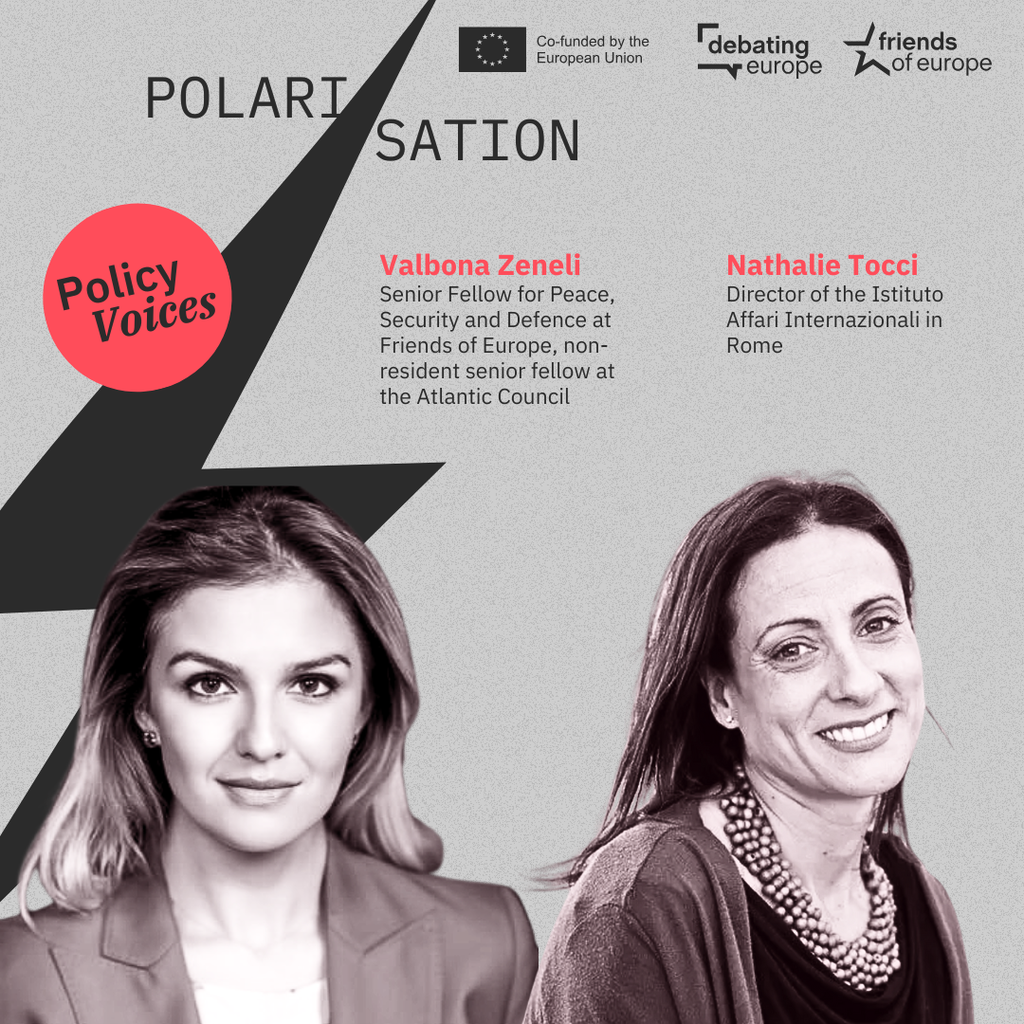From ambition to action: building Europe’s Defence Union
Past event In person

- Area of Expertise
- Peace, Security & Defence
Peace, Security & Defence

Senior Advisor at Defend Democracy, Lecturer at the Institute for Security Governance and former Senior Fellow at Friends of Europe.
Throughout history, the great trading powers have also been great maritime powers. From the Phoenicians in the BCE era to the Venetian Republic, Portuguese Empire, Dutch Republic, British Empire and more recently the United States, these great trading powers honed their maritime prowess to secure trade routes, protect their interests, project power and access valuable resources. These factors collectively contributed to their success in global trade and helped maintain their status as leading powers.
The European Union is a major trading power in the global economy, forming one of the largest single markets in the world. The EU has a strong influence on international trade due to its collective economic strength, the size of its market and its extensive network of trade agreements.
The EU has been able to achieve steady economic growth while maintaining modest maritime capabilities due to a more secure and cooperative global maritime environment largely policed by the US Navy. But this dynamic is shifting and with it the need for the EU’s maritime power to match its trading power. The hill the EU must climb to achieve this is not as steep as it may appear. Despite the atrophy of European land forces since the early 1990s, her maritime forces have been maintained, modernised, operated globally and held to a much higher level of readiness than other security forces.
This of course was no accident since the maritime domain is vital for Europe’s security and prosperity due to its heavy reliance on sea trade for imports, exports and energy resources. Securing sea routes is crucial for maintaining economic growth and the shift to liquified natural gas (LNG) delivered by sea only increased its importance.
Ensuring the security of these supply routes is vital for maintaining Europe’s energy security and preventing disruptions that could have severe economic and geopolitical consequences. Europe also faces various security challenges along its maritime borders, including illegal migration, human trafficking and smuggling of drugs and weapons. Finally, the maritime domain plays a critical role in Europe’s efforts to preserve and protect its marine environment and resources. So, for Europe, maritime security remains vital to ensuring its safety, security and prosperity.
The headlines on European defence always speak of an EU army but it’s an EU navy that has quietly been emerging
In March 2023, the EU introduced its latest Maritime Security Strategy. This new maritime strategy is not only an updated and enhanced version of its inaugural maritime strategy from 2014, but it builds on the 2022 Strategic Compass, which was released just one month after the latest Russian invasion of Ukraine. It also builds on the EU’s 2021 Strategy for Cooperation in the Indo-Pacific as part of a series of recent political and practical efforts to demonstrate Europe’s commitment to reinforcing its role in regional security.
Even a decade ago, the maritime environment was more cooperative, with a stronger focus on non-state threats like piracy and terrorism. The realisation that a period of increased state-based competition was emerging had only just begun, so capability aspirations in the 2014 version were relatively modest compared to the new strategy, which describes a more complex and contested maritime landscape. Thus, the new strategy calls for a greater emphasis on the hard power aspects of maritime defence and security, where the EU had previously faced challenges in establishing a role and identity.
More recently, the EU has sought to enhance security and capacity-building in the Gulf of Guinea, designated as a maritime area of interest (MAI) and seen the first implementation of the EU’s coordinated maritime presence (CMP), which may have helped reduce instances of piracy in the region. The EU has expanded these concepts to the northwest Indian Ocean, potentially supporting endeavours like the EU Naval Force (EU NAVFOR) – Operation Atalanta, the Union’s counter-piracy mission, and the European-led Strait of Hormuz maritime monitoring mission (EMASOH). There has also been an emphasis on maritime security missions in the Mediterranean, such as Operation Irini to enforce the United Nations arms embargo to Libya during the Second Libyan Civil War.
In many ways, the headlines on European defence always speak of an EU army but it’s an EU navy that has quietly been emerging.
That said, the EU’s ambition to engage in the wider Indo-Pacific region has proven more challenging. Among the challenges are a maritime focus closer to European waters and limited naval resources for power projection, now exacerbated by new security requirements related to the Russia-Ukraine War.
We can expect to see an increased European naval presence in the region
The new maritime strategy suggests the EU will consider new MAIs, with the Indo-Pacific described as “an area of intense geopolitical competition”, implying it could be the next one to be designated. The strategy calls for EU member states to expand their presence and action into the region, including through port visits and exercises. The 2021 EU Indo-Pacific strategy also called for a “meaningful” European naval presence and expressed the intention to explore enhanced naval deployments, an ambition that was also reinforced in the 2022 EU Strategic Compass.
Despite concerns that Europe’s interest in Asia would diminish following Russia’s 2022 invasion of Ukraine, the opposite has occurred. China’s support for Moscow has caused Beijing’s image in Europe to plummet, fostering consensus and raising awareness in European capitals about East Asia’s security concerns. The growing military alignment between the two authoritarian regimes has also reinforced the idea that Asian and European security are interconnected.
The EU has strengthened its relationships with partners in the Indo-Pacific with maritime security as a primary focus. Since 2021, the EU NAVFOR Atalanta and the Japanese Maritime Self-Defense Force (JMSDF) have conducted three joint naval exercises in the Arabian Sea. In March 2023, both sides signed an Administrative Arrangement to solidify cooperation and enhance interoperability. During this time, Atalanta also held joint naval exercises with South Korea, India and Indonesia.
France, itself an Indo-Pacific power with significant territory and a large exclusive economic zone in the region, has been a key proponent of this ambition. Paris has been increasing its maritime presence in the Indo-Pacific, with Italy, Germany and the Netherlands (sailing with a UK-led carrier strike group) also conducting naval deployments to the region. These deployments included port calls and joint naval exercises with India, Japan, South Korea, Singapore, Australia and the US. However, translating this into a more sustained EU presence under CMP remains a challenge given limited resources and higher force demands closer to home.
Regardless, we can expect to see an increased European naval presence in the region, including plans for France to deploy its Charles De Gaulle carrier strike group to the region by 2025. Most countries in the region welcome this increased European maritime presence as another stabilising force in the region, but questions remain about whether this presence can be counted on in case tensions rise.
Given the hard power strengths of NATO, its members will probably prefer for the alliance to remain the primary maritime security actor
A significant change since 2014 has been the UK’s exit from the EU, causing the Union to lose one of the two major European naval powers with a global reach and outlook. However, a recent UK-France summit resulted in a pledge by both sides to coordinate aircraft-carrier deployments, which can serve as a foundation for sustained European maritime presence in the Indo-Pacific. Collaborating in this manner may be crucial for both London and Brussels to build a ‘whole-of-Europe’ approach to achieve Europe’s broader Indo-Pacific maritime goals and could serve as an opening for future talks on EU-AUKUS maritime cooperation in the region.
Another challenge to the EU’s global maritime vision is the increased need for attention closer to home. The strategy identifies the protection of critical infrastructure in the maritime domain as a key priority. Concerns regarding undersea infrastructure in Europe’s northern and southern waters are only increasing as renewed efforts to secure undersea cables and energy pipelines have grown since the 2022 Nord Stream incident.
The revised maritime strategy also spells out a new level of ambition on capabilities, emphasising strengthening abilities to achieve EU “surface dominance, power projection at sea, underwater control, and contributions to air defence.”
Additionally, there are plans to launch an annual EU naval exercise starting in 2024 to improve readiness against both traditional threats and hybrid threats, plus emerging threats associated with climate change. This expanded EU maritime ambition includes information sharing and sending liaison officers to regional information fusion centres, including a new EU liaison officer at the Information Fusion Centre in Singapore.
EU member states are also very active in defence trade in the region with the development of new submarines to the delivery of Dutch and French frigates, submarines and fighter jets for Taiwan. France and Italy have also been quite active in the sale of various navy vessels to Indonesia while German companies are working on new submarines for Singapore.
Closer to home, EU member states are currently undergoing an intensified period of naval rearmament. However, the war in Ukraine has revealed some overall defence shortfalls in other areas that are demanding attention and resources, potentially slowing and downsizing naval rearmament programmes. Current EU maritime capability development initiatives include a patrol corvette programme and the development of unmanned maritime vessels. It remains to be seen if these initiatives will provide a significant boost to the EU’s high-end capabilities.
The updated maritime security strategy also highlights enhanced EU-NATO relations and encourages further collaboration. The longstanding issue of the division of labour between the two organisations persists and both sides will need to adapt to new realities. Given the hard power strengths of NATO, its members will probably prefer for the alliance to remain the primary maritime security actor in the Baltic and Black Sea regions while sharing duties in the Mediterranean and Arctic. In the broader European region, the EU may be best suited to lead on countering piracy, enforcing arms embargoes and countering illicit trafficking.
This collaboration is a vital part of the NATO 2030 agenda
When it comes to the Indo-Pacific region, the division of labour is less clear. NATO is strengthening ties with Indo-Pacific partners, including Australia, Japan, South Korea and New Zealand, to address global security challenges and maintain international order. NATO members, including the US, the United Kingdom, Canada, France, Germany and the Netherlands, have also operated in the region and exercised with partner navies in the Indo-Pacific.
This collaboration is a vital part of the NATO 2030 agenda, involving increased political dialogue and cooperation in various areas. In June 2022, Indo-Pacific partners attended a NATO summit for the first time, emphasising the importance of collaboration among like-minded nations in the face of global strategic competition. The alliance also just announced a new liaison office in Japan to help manage relations with partners in the region.
The EU’s ambitions in the region have been clearly stated in recent strategy documents and demonstrated through similar joint exercises, port calls and maritime presence in the region. Given both NATO and EU challenges in sustaining a maritime presence in the region, cooperation on maritime logistics, communications and intelligence could be areas to explore on NATO-EU maritime cooperation in the Indo-Pacific.
The inherent flexibility of maritime forces also means that vessels from members of the EU and NATO can lower their ensign from either organisation and raise the one of the other (or the UN or revert to national mission control) depending on requirements and priorities – provided there is a UN, NATO or EU naval formation to (re)join.
But constructive contributions to maritime security don’t always need to involve military forces. A major part of the EU’s engagement in the region includes supporting the UN Convention on the Law of the Sea (UNCLOS) and promoting a rules-based order at sea. This remains especially important since the rule of law is regularly challenged within the various regions that the new EU maritime strategy seeks to influence, cooperate and maintain a stabilising presence.
In addition, the EU’s commitment to protecting the marine environment and promoting sustainable solutions to climate change and marine pollution also makes it a welcome actor in the Gulf of Guinea, Western Indian Ocean and Southeast Asian waters.
The views expressed in this #CriticalThinking article reflect those of the author(s) and not of Friends of Europe.
Past event In person

Next event In person & Livestreamed

Past event Online

Past event Online





Stay informed
We use cookies and similar technologies to adjust your preferences, analyze traffic and measure the effectiveness of our campaigns. Learn more about our privacy policy.